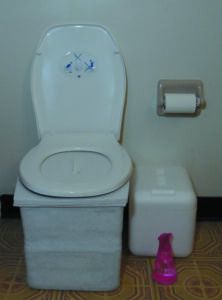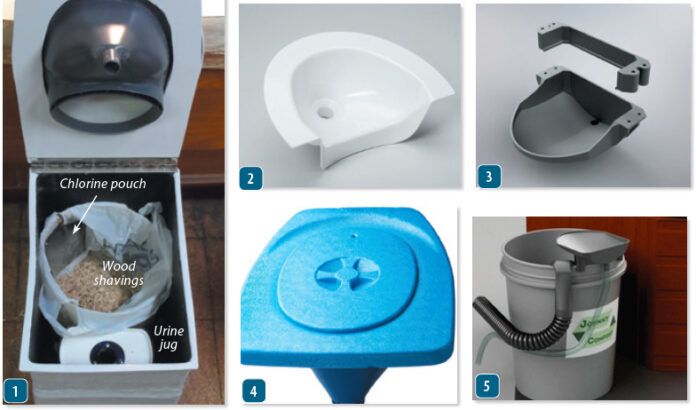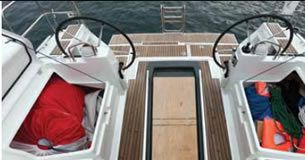No standard dry toilet, even the CHead Shorty, would fit the available space on our Corsair F-24, so we decided to build our own. We considered building the base from plywood and fiberglass, but we found a pair of surplus fiberglass battery boxes we could cut and join for a perfect fit. Since the exterior would not be visible, we left the finish rough.
We cut a 5-gallon bucket down to about 3 gallons and reinstalled the handle. A rectangular kitchen grain container with a tightly fitted lid fit the skinny space available for the urine container, and we added a filler neck and screw top from a laundry detergent bottle.
We sourced a DIY kit for the molded parts that make up the seat and urine diverter, cut a top sheet from -inch plywood and painted it white. A lid made from a sheet of fiberglass shower surround material blocks any odors that might escape when not in use. We glued a handle on it.
We opted for the no-churn method because it allowed us to bag waste, which simplified servicing for day and weekend use. The boat is in a multiple-user partnership, home is an hour away, and our use is primarily day sailing, with only the occasional 1-2 night trip.
Here are a few of the DIY parts options we looked at. Most of the kits are imported from Europe, so the prices are high.

DIVERTER WITH SEAT
Sure, some hardcore campers happily endure a seatless ammo box (aka the “groover”)—but we suggest splurging on a seat.
C-HEAD DIY KIT
Available in churn and non-churn versions, the C-head DIY kit is nearly as expensive as a complete C-head (see page 23). It is made in the US.
Bottom line: This is our Best Choice, but we’d just buy the whole C-head unless it just couldn’t fit.
THE SEPARETT PRIVY 500
This inexpensive foam seat is said to be warm in the winter, but there is no lid, and there were several online reports of premature breakage. It is made in Sweden. We did not test it.
Bottom line: Not recommended.
SEPARETT PRIVY 501
It’s odd that for the same $150 that gets you only a seat, cover, and separator, you can buy a complete manual head—the power of mass production at work.
Bottom line: Recommended, and the one we tested.

FRONT SEPARATOR AND CHUTE
You’ll need to supply your seat—about $30 through any hardware store.
There are full kits, and several variations of a funnel (see photo #3, facing page). The one that made sense to us was the mounted version. The others require cutting out part of the bucket. The modified bucket will probably still work with bags, but they won’t fit as well as they do on a complete bucket.
JOHNNY COMPOST
We did not test this particular system, but it had fairly good reviews. It seems there is surplus supply of urine diverters out there, so there are many options.
Bottom line: We didn’t test them, but the stand alone diverter is cheap and certain options would allow an even more compact design.
VALUE GUIDE: URINE DIVERTER SEATS AND CHUTES
| MANUFACTURER | MODEL | TESTED | MATERIAL | FOLDING SEAT AND COVER | OPENING COVER | SEAT | INNER COVER | PRICE |
|---|---|---|---|---|---|---|---|---|
| MODEL | ||||||||
| C-HEAD | DIY w/churning bowl | No | Hard plastic | Yes | Yes | Yes | Yes | $549 |
| C-HEAD | DIY kit, no churning | No | Hard plastic | Yes | Yes | Yes | Yes | $429 |
| SEPARETT | Privy 501 | Yes | Fiberglass | Yes | No | Yes | No | $150 |
| SEPARETT | Privy 500 | No | foam | No | Yes | Yes | No | $119 |
| SEAT | ||||||||
| KILDWICK | Classic Urine Separator | No | Fiberglass | No | No | No | No | $190 |
| SEPARETT | Privy 400 | No | Fiberglass | No | No | No | No | $118 |
| FUNNEL ONLY | ||||||||
| KILDWICK | Compact Urine Separator | No | Fiberglass | No | No | No | No | $130 |
| JOHNNY COMPOST | Mounted Urine Diverter Only | No | polyethylene | No | No | No | No | $45 |
FRONT SEPARATOR ONLY
A urine chute simplifies the separation of urine from solid waste, and is helpful especially for women. THE SEPARETT 400 This toilet has the same front half as the 501, but is difficult to find.
Bottom line: This head is a more compact design than the Separett 500.
SMARTFLOW URINE DIVERTER
This $65 polyethylene diverter mounts easily, but you will need a separate seat and receptacle for solid waste.
Bottom line: This is a cheap solution that might save space.
FUNNEL
There are also home grown versions on the internet built using a funnel and a cutaway bucket.
Bottom line: No thanks.
MAKING THE BOX
Building the box for your bucket and diverter is mostly a matter of building a box. The seat is pretty much like any home toilet seat, but with a urineseparating funnel and optional chute mounted under the seat. A hose allows placing the urine jug wherever it will be out of the way, or you can do as we did and align everything so that the stub fits closely in the urine container. We considered fitting a carbon filter, but with the bleach pouch there was no need. Our pouch was sewn from beach cat trampoline material. You can add ventilation. Johnny Compost sells vent kits that include a computer fan and the required adapters and duct work.
A simpler solution is to cut a custom lid from a fiberglass shower wall panel (0.09 inches thick) that fits neatly between the seat and the diverter, equipped with a low-profile handle. Just remove it before use, and then replace when done. Many desiccating toilets use similar lids or plugs.
The top sheet (the board that the seat is attached to) hinges upwards, either back or to one side, providing access to the bucket and urine jug.
We considered a slide-out lid design, but the Separett 501 diverter has a chute that extends into the bucket and the urine funnel extends into the jar. Fabricate a lid to close off the opening between uses; there is very little smell, but it’s better to be safe.










































Hi Darrell-
I’m inspired by your desiccating toilet solution. Do you have any other photos or drawings you could share? I am trying to cram something similar on the port side of my daggerboard in my F31. Im trying to fit the Kildwick system but can’t center the pee bottle under where I want the urine diverter to go. Sounds like you got around this by hacking your own bottle? Would love to see the details. thanks, Jonathan